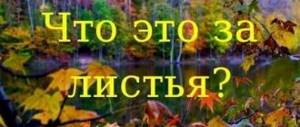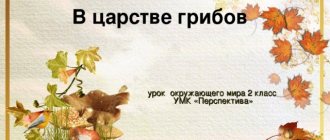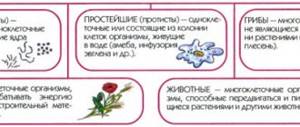Lesson about the world around us, 1st grade. What's growing in the flowerbed? School of Russia
Lesson summary on the surrounding world in 1st grade on the topic “What grows in a flowerbed?”
UMK A. A. Pleshakov (“School of Russia”) Objectives : to introduce ornamental plants to flower beds and flower gardens; continue to learn to recognize plants. Planned results : students will learn to recognize the plants of a flower bed using an atlas-identifier. Equipment : bouquets of flowers (gladioli, marigolds, cosmos, calendula, petunia, dahlias), a school dictionary “Plants of Russia”;
Students have colored pencils, scissors, glue, and colorful chips. Lesson progress
I. Organizational moment II. Updating knowledge - What plants did we meet in the last lesson? — What indoor flowers did you learn about at home? (Children's answers.) - How did you find out the names of plants? (Using an atlas-identifier, they asked adults.) - What indoor flowers did you read about in the school dictionary? (Children's answers.) (The teacher once again shows the flowers that are in the class, the students name them.) Now you and I, and Ant Question, know what grows on the windowsill. (You can use CMMs (test 5, p. 10). The test is performed under the guidance of a teacher.) III. Self-determination for activity Guys, today Ant is in a great mood, which he wants to share with you. To do this, he brought bouquets of flowers to class. And along with the bouquets he gives a poem. We make bouquets of flowers, Picking flower after flower, And fragrant fresh summer Comes to our home with them. You are proud of the beauty of your outfit, Our guests from the school garden are flooded with the light of sunny days, Our parks and squares are filled with flowers! — What colors are we talking about in Ant’s poem? (About the flowers that grow in the garden in a flower bed.) (On the shelf in front of the board there are bouquets of flowers: asters, cosmos, gladioli, calendula, marigolds, petunias, dahlias.) - Do you know the names of these flowers? (Children's answers.) - Can you guess what we will talk about in class today? (About the flowers that grow in the flowerbed.) - Formulate the learning objective of the lesson. (If students do not succeed, then they should turn to the textbook and read the first paragraph of the text on p. 26.) IV. Work on the topic of the lesson - Open the textbook on p. 26. Look at the pictures, maybe they will help you determine the names of the flowers collected from the flower bed. (Students read the names of plants and match the picture in the textbook with the plants in the bouquets.) - Which of these plants did you see in a flowerbed or in a summer cottage? Mark them with chips. — Look at the bouquet of cosmos. What can you say about this flower? (The flowers are bright, different colors: white, pink, red, yellow.)
Cosmea means "decoration". These flowers are truly a decoration for the garden. - Now listen to a short poem and tell me what plant we are talking about and what this flower is compared to. The aster with its straight petals has been called a “star” since ancient times. That’s what you would call it yourself, In it the petals scattered like rays From the core, completely golden. (The poem talks about an aster; it is compared to a star.)
- Look at this plant. What can you tell us about him? (Asters are very beautiful. They look like stars. Flowers come in different colors.) - What flower is the following poem talking about? What is this flower compared to? At the porch of our school, a fresh flowerbed was guarded by a gladiolus (in Latin it means “sword”). (About gladiolus. It is compared to a sword.)
- Why do you think? (Gladiolus leaves are shaped like a sword.) - What flowers did Question Ant collect his bouquet from? (Students look at the Ant bouquet and name familiar flowers.) - What are the names of the flowers in these bouquets? (The teacher shows bouquets of marigolds, petunias, calendula, students compare them with photographs in the textbook and name them.) V. Physical education lesson We see two cheerful frogs jumping along the edge. Jump-jump, jump-jump - Jump from heel to toe. In the swamp, two girlfriends, two green frogs, washed themselves early in the morning, rubbed themselves with a towel, stomped their feet, clapped their hands, leaned to the right, left, and returned back. That's the secret of health. Hello to all physical education friends! VI. Continuation of work on the topic of lesson 1. Practical work in pairs (Students, using an atlas-identifier, name one or two plants from the school flowerbed. Then complete the task in the workbook (p. 15, No. 1) and report the results of their work.) 2 Work according to the textbook - Look at the photographs on p. 27. - Which of these plants are familiar to you? What are their names? Discuss this question in pairs. — Find out the names of other plants using the atlas-identifier. (Self-test using the textbook (p. 89).) 3. Completing tasks in workbook No. 2 (p. 15).
- Look at the pictures.
Collect flowers from them. (Check.) - What flowers were you able to collect? (Petunia, cosmos, gladiolus.) No. 3 (p. 16). - Find it on p. 61 attachments to this task and cut along the lines. - Collect a flower bed and stick it on. What flowers are there in this mosaic? — What other flowers grow in the flower beds? Where have you seen flower beds in our city? 4. Conversation - How to care for garden flowers? (They definitely need to be watered.) They can also be fed with fertilizers. You can find out about this from your grandmother or mother. They will tell you which fertilizer is best to choose for this type of flower. We all love flowers very much, because they decorate the planet and make our lives happier. So let's take care of the beauty of our nature! Let's walk slowly through the garden and say “hello” to every flower. I have to bend over the flowers, not to pick or cut them, but to see their kind faces and show them a kind face. VII. Reflection (Students answer questions in the textbook (p. 27, in the box).) - Evaluate your achievements in the lesson. (Students take out one of the signs and explain their choice.) VIII. Summing up the lesson - Why are flowers grown? _What can you do to preserve this beauty? (Take care of plants, do not pick flowers from flower beds, do not break or trample them.) (The teacher reads a poem.) Flowers, like people, are generous with goodness, And, generously giving tenderness to people, They bloom, warming hearts, Like little warm ones bonfires. Recommendations for studying at home 1. Workbook: No. 4 (p. 16-17).
2. Together with adults, read in the school dictionary “Plants of Russia” about some plant from the flowerbed. Additional material
Dahlias About two hundred years ago, beautiful flowers - dahlias - came to Europe from South America. They got their name in honor of the botanist I.I. Georgi. The color and shape of these flowers are so diverse that flower growers have already developed more than 8 thousand varieties. * * * Autumn pictures are freezing, The garden has been crumbling for a long time, But in the proud beauty of the dahlias, they stand alone, without bending. * * * He stands on a long leg, like a ballerina dancing. Like a bouquet, there is only one flower - Dark red dahlia. Carnations Carnations have been universally loved for their aroma and beauty since ancient times; it is not without reason that the scientific name of this genus is translated from Greek as “God’s flower.” The origin of the English names for this plant, of which there are quite a few, is interesting. One of them, for example, means “meaty” and hints at the red color of the corolla. And the other, although similar to the English word “pink,” comes from the Dutch “White Day.” In all likelihood, this name is associated with the time of mass flowering of carnations - seven weeks after Easter. The British call the Turkish carnation “Darling William” - in honor of William, Duke of Cumberland, who defeated the Untiv Jacobins in 1746 at the Battle of Culloden. True, in retaliation, they dubbed the foul-smelling cross “Stinky Billy.” By the way, the spice cloves are the dried buds of a completely different plant, the clove tree from the Moluccas Islands; its name speaks only of an aroma reminiscent of the smell of garden carnations. * * * Look, look, what is that red light!? This cute carnation is celebrating New Day. And when evening comes, the flower will fold its petals: “Until the morning!” See you!" - And put out the light. * * * Everyone is familiar with us: Bright as a flame, We are namesakes With small nails. Admire the wild Scarlet... (carnations). Iris This plant loves moisture and is used to decorate the banks of reservoirs. This flower also loves the sun and warmth. Flowers come in different colors: blue, purple, white, yellow. Gladiolus In the second half of summer, gladioli begin to bloom. Tall, with large bright flowers of a wide variety of colors, blooming one after another from bottom to top of the stem. Gladiolus is an alien from South Africa. It received its name for the resemblance of its leaves to the blade of a formidable weapon (Latin gladius - sword, sword; hence, by the way, gladiator). In our country this word came into use quite recently, in the 30s of the 20th century. And before that, the beautiful flower was simply called the sword. Tulip When the Dutch professor of botany Carl Clusius at the end of the 16th century. Bringing a collection of tulip seeds home from Turkey and growing bulbs from them, he laid the foundation for a new hobby that eventually became national. Over the course of several years, “tulip mania” swept across the whole of Holland. Precious bulbs changed hands for hundreds of guilders, and entire fortunes were gambled for new varieties. Particularly popular were striped and spotted tulips, created, as we now know, by viruses, and not by the art of gardeners. Nowadays, the crazy speculation has already ended, but the tulip has managed to firmly take its place as a favorite flower throughout Europe. These flowers are still widespread and number more than 100 species and 2 thousand varieties. * * * The spring sun rose with a smile, Throwing its beam onto the clearing, Where the Tulips waltz in a dance like a scarlet wave in the light wind. Narcissus Narcissus is a perennial plant. It blooms early, delighting with the pleasant aroma of flowers. Daffodils come in both single and double flowers. One of the ancient Greek myths tells of a beautiful young man named Narcissus, who rejected the love of the nymph Echo and was punished for this by the goddess of retribution Nemesis by falling in love with his own reflection in the water. The nymph Echo yearned and withered away until only her voice remained, and Narcissus spent his days sitting on the shore of the lake and constantly admiring himself. In the end, he fell into the lake and drowned, and in this place a beautiful and proud flower grew - a narcissus. Astra Astra is a Greek word and means “star.” Look at the aster flower - its petals really look like the rays of a star. For asters to bloom, they must be planted in a sunny area. Pansies We have blue pansies growing in our front garden near the terrace. Pansies, Pansies, They bloom quickly, like in a fairy tale. Lily The lily has dressed up in a wedding dress, The summer garden is full of the aroma of sweets.
We recommend watching:
Lesson about the world around us, 1st grade. What do different plants have in common? School of Russia Lesson of the surrounding world, 1st grade. What's growing on the windowsill? School of Russia Lesson notes on the world around us, 1st grade. What are insects? School of Russia Lesson of the surrounding world in 1st grade. What can a computer do? School of Russia
Similar articles:
Excursion “What do we know about the rules of the road?”, 1st grade
Lesson about the world around us in 1st grade. Where do snow and ice come from?
Lesson notes on the world around us, 1st grade. How to help birds in winter. Pleshakov
Lesson about the world around us, 1st grade. When is it interesting to study? School of Russia
Lesson about the world around us, 1st grade. Where do polar bears live? School of Russia
Presentation “What grows in a flower bed” presentation for a lesson on the world around us (grade 1) on the topic
Slide 1
What's growing in the flowerbed? The world . 1 class. To the textbook by A.A. Pleshakov.
Slide 2
In flower beds and flower beds you can see a huge number of bright, beautiful flowers. They are varied in color, shape and size. I will tell you about some of the most famous flowers.
Slide 3
Gladiolus is like a lush ear.
Slide 4
Calendula (marigold) is a medicinal plant. Decoctions and infusions are made from its flowers to heal wounds.
Slide 5
The poppy is a sissy, its large petals quickly fall off. In ancient Rome, the poppy was the sacred flower of the god of sleep, Morpheus.
Slide 6
Peony is a medicinal plant. It is named after Peon, a doctor from ancient Greek myths who used this flower to heal the gods.
Slide 7
Astra – translated into Russian means star. According to legend, the first aster grew on the spot where a fragment dropped to Earth by a flying star fell.
Slide 8
Hyacinth - dedicated to the god Apollo. In Greece, this plant was considered a symbol of sadness. Legend has it that hyacinth grew from the blood of the young man Hyacinth, who died during a sports competition.
Slide 9
Narcissus. A long time ago in Greece there lived a beautiful young man named Narcissus. For his excessive love for his appearance, he was severely punished by the Gods. Until the end of his days, Narcissus was doomed to constantly admire his own reflection in the pond.
Slide 10
Pansy - it used to be a forest plant. The Germans call him stepmother. They explain this name by the structure of the flower. The lower, largest and most beautiful petal is the stepmother. The two side ones, smaller, but also beautiful, are her own daughters, and the two smallest ones, the top ones, almost unpainted, are her stepdaughters.
Slide 11
Tulip, these flowers got their name from the Persian word “turban” - turban (headdress).
Slide 12
Dahlia. Two hundred years ago, tubers of an unknown Mexican plant were brought from South America. The first flower that grew was named after the Russian academician naturalist and traveler Georgi.
Slide 13
The ancient Greeks and Romans celebrated hyacinths and lilies.
Slide 14
The British had a holiday of peonies and lotuses.
Slide 15
The Slavs celebrated Ivan Kupala Day on July 6, the symbol of which was the fern.
Slide 16
In France in the old days there was a holiday of roses, and now there is a holiday of lily of the valley.
Slide 17
In Cannes, Mimosa Day is held in February.
Slide 18
In Bulgaria they celebrate Rose Day, and in Great Britain they celebrate Poppy Day.
Slide 19
In Holland, lush carnivals of flowers are held.
Slide 20
What flowers can you name and what do you remember about them? Why do people plant flowers in flower beds?








